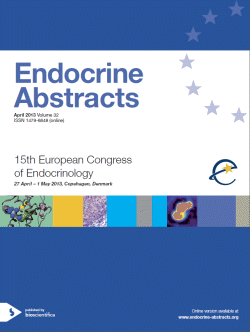Searchable abstracts of presentations at key conferences in endocrinology
Symposia
Clinical care of the pheochromocytoma patient
ea0032s14.1 | Clinical care of the pheochromocytoma patient | ECE2013
Clinical care of the pheochromocytoma patient
Paragangliomas (PGLs) derive from either sympathetic tissue in adrenal and extra-adrenal locations, or from parasympathetic tissue of the head and neck. Adrenal PGLs are usually referred to as pheochromocytomas. Most patients with adrenal and extra-adrenal abdominal PGLs have increased plasma and urine concentrations of catecholamines (dopamine, norepinephrine and epinephrine). Typical symptoms and signs of catecholamine excess include headache, palpitations, diaphoresis, and ...
ea0032s14.2 | Clinical care of the pheochromocytoma patient | ECE2013
Pheochromocytoma imaging
Pheochromocytomas (PHEO) and paragangliomas (PGL) are neuroendocrine tumors that were born to be imaged using specific radiopharmaceuticals. This is based on the expression of the cell membrane norepinephrine transporter system and somatostatin receptors, as well as GLUT and amino acid transporters found on PHEO/PGL cells.Anatomical imaging modalities (e.g. CT or MRI) may define the size, shape, structure and enhancement of tumors well, but they lack the...
ea0032s14.3 | Clinical care of the pheochromocytoma patient | ECE2013
Treatment of malignant pheochromocytomas and paragangliomas
Pheochromocytomas and paragangliomas are rare neuroendocrine chromaffine tumors located in the adrenal or extra-adrenal sites, respectively. Malignant pheochromocytomas or paragangliomas represent 1020% (MPP) of these patients and are defined by the presence or occurrence of metastasis, in non chromaffin organs. MPP are characterized by their heterogeneous presentation as testified by their variety in primary locations, levels and type of hormone secretions, percentage o...




